
Spreading their wings – November 2015, Canadian Packaging
By George Guidoni, Editor; Photos by Cole Garside
Automation Design & Innovation Food Safety Bottling Coding & Labeling Flexibles Metal Detection X-Ray Alpla North America Amcor Inc. Atlantic Packaging Products Ltd. Avery Weigh-Tronix Berry Plastics Corp. CHEP Canada Ltd. Columbia Machine Inc. Eagle Product Inspection Enercon Corporation LAN Automation Markem-Imaje Nordson Canada Limited Ryson International Inc. Serac Sidel Group Sleever International slideshow Videojet TechnologiesLandmark Canadian Unilever factory leverages formidable processing and packaging competencies to rise to the next higher level of food safety and quality excellence.
Caption: Production manager Mandeep Atwal (left) and factory director Galen Sienicki pose in front of one of the Rexdale plant’s high-performance Eagle Pro X-Ray product inspection systems installed to ensure optimal food safety standards.
For relative newcomers to the place, factory director Galen Sienicki and production manager Mandeep Atwal have witnessed and guided a remarkable number of far-reaching and exciting recent changes at the landmark Unilever Canada spreads and dressings production facility in Toronto’s west-end neighborhood of Rexdale—home to some of Canada’s bestselling brands of margarine, mayonnaise, dressings and other condiments that have either dominated or thrived in their product categories for as long as most modern Canadian consumers can recall.
Producing a total of 100 million liters of the perennial stalwart super brands like Becel margarine and Hellmann’s mayonnaise per year, the busy 100,000-square factory—operated by the multinational consumer packaged goods powerhouse Unilever since 1961—is naturally also one of the most important manufacturing assets in the company’s far-flung global manufacturing operations, nowadays supplying not only the entire Canadian market but also exporting a sizeable share of its output into U.S. markets as part of its critically important North American manufacturing mandate.
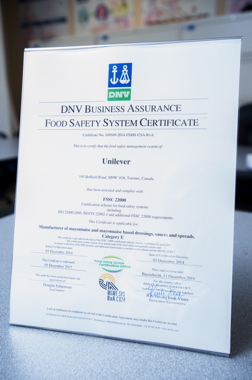
The official FSSC certificate validates the plant’s ongoing compliance to the highly rigorous food safety standards.
But rather than being awed by the weight of responsibility that comes with the job of ensuring the plant runs each shift at optimal productivity and efficiency levels, Sienicki is more happy to keep taking on more challenges and initiatives to keep the venerable Rexdale facility, which he joined last April, near the top of its food chain through continuous improvement and innovation.
“This is a key plant to Unilever, especially when measured in terms of SKU (stock-keeping units) produced here,” Sienicki told Canadian Packaging during a recent visit to the 130-employee, three-shift, five-days-a-week operation that has already undergone some key milestone changes since his arrival.
“When you look at the top-selling 25 food SKUs produced by Unilever in Canada, also including a dry foods plant in nearby Bramalea and the ice-cream plant in Simcoe, Ont., you have to go pretty far down the list, to eighth, before finding a product that’s not produced in the Rexdale plant,” says Sienicki, who also serves as factory director for the Simcoe operation that manufactures the famed Breyers brand of ice-cream products.
Since joining the Rexdale plant, one of Sienicki’s first and most important orders of business has been to oversee the completion of the plant’s certification to the new international FSSC (Food Safety Systems Certification) food safety standard of the ISO (International Standards Organization), which he says is “much more rigorous and more universally accepted” than the plant’s long-held, but somewhat outdated, food safety certification issued by the BRC (British Retail Council).
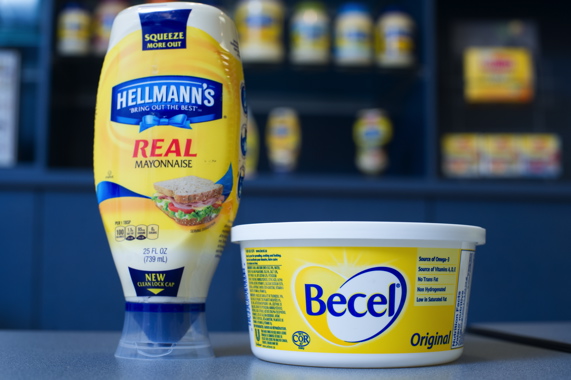
Both produced at Rexdale, Hellmann’s mayo and Becel margarine are Number One topselling brands in their respective product categories in the Canadian market.
Initially FSSC-certified about a year ago, the plant has since passed through an extensive, three-day “surveillance audit” by independent third-party auditing authorities in flying colors to validate and maintain its hard-earned accreditation.
According to Atwal, achieving the vaunted FSSC certification positions the Rexdale plant as one of many Unilever plants in North America to complete the conversion, which the parent company has mandated for all of its North American production sites.
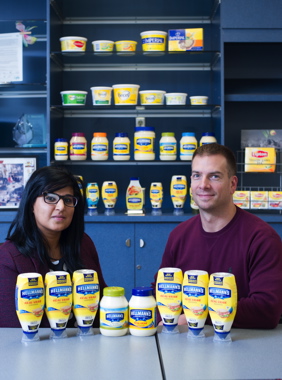
Mandeep Atwal (left) and Galen Sienicki show off the company’s innovative new upside-down, squeezable plastic bottles now being used to package the company’s bestselling Hellmann’s brand of mayonnaise and other popular dressing products in Rexdale.
“The plan is for all the Unilever plants to go this route under the guidance of our global quality excellence team,” says Atwal.
“All the Unilever food factories are already somewhere along this journey, be it at initial audits, stage-two audits or surveillance audits,” she says. “We’re not all just quite there yet locally, but it’s an exciting journey that will be well worth all the hard work when it is completed at all or sites.”
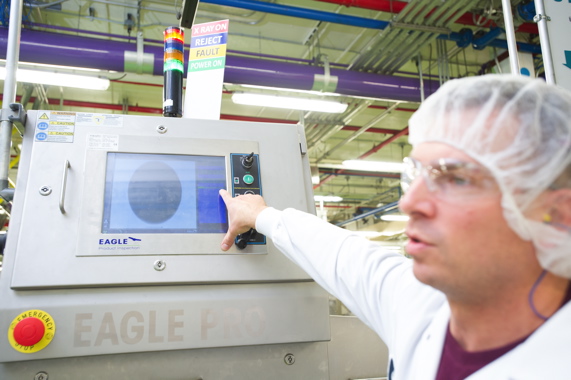
Galen Sienicki points out some the of powerful capabilities, including inline checkweighing, offered by the recently-installed Pro Eagle X-Ray inspection system, supplied by PLAN Automation, on one of the plant’s margarine packaging lines.
As Sienicki explains, “Our goal is to have one industry standard certification that more of our partners and consumers will accept as a qualified and authoritative food safety program, whereby the major vendors from who we receive certain materials, like Hershey sending their confectioneries to our Simcoe plant, will not feel compelled to come and carry out their own audits to reassure themselves about our food safety practices.
“They are welcome to any time, of course, but having FSSC certification essentially makes that redundant,” says Sienicki, pointing out that other Unilever divisions like beverages and personal-care product area also following suit with their FSSC certification efforts.
Happily for the naturally upbeat Sienecki, dealing with change comes a lot more naturally than for most people on account of being raised as an “Air Force brat” by a U.S. Air Force pilot stationed around Europe, followed by a return to the U.S. to complete his high-school and university education.
“I have yet never lived in one country or state for more than five years,” remarks Sienickie, holder of an undergraduate degree in Chemical Engineering from Rutgers University in New Jersey, followed by an MBA from Baker University in Kansas.
“But I’m loving it here in Canada so far,” he adds, “and very excited to be involved in what’s unfolding here in Rexdale.
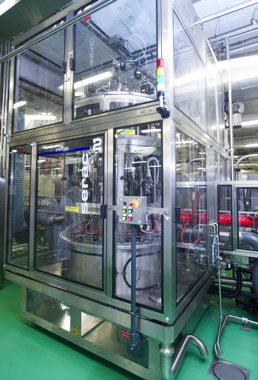
A custom-designed Serac oiler used to spray clean empty bottles with oil mist.
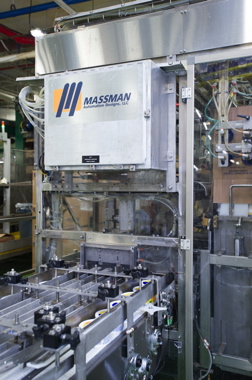
Freshly-filled tubs of margarine transferred inside a Massman case-packer.
“Since April, the plant has gone through a lot of changes: the way we manufacture spreads; in our processing capabilities; and a number of things with our plant layout,” Sienecki relates.
“We will also soon demolish the aging refinery outdoors, which has actually been out of operation for a number of years now,” he notes, “using the property to enable some key logistics cost-efficiencies, like a more strategic staging of trailers for transportation.”
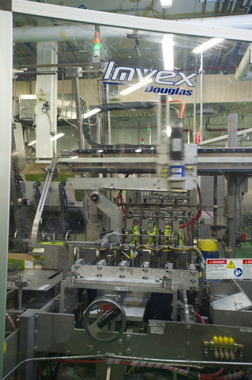
The Invex IM wraparound case/tray-packer with a lane-divider from Douglas Machine.
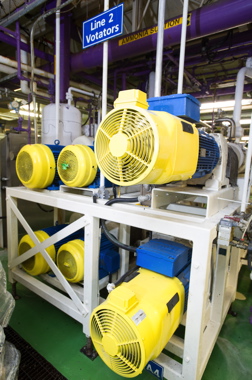
Heavy-duty SEW-Eurodrive electric motors are a common sight throughout the busy Rexdale plant.
On the processing side, Sienicki relates, the plant has fully embraced a new high-efficiency batch production process that fully complements the facility’s food safety focus and waste reduction efforts.
Says Sienicki: “Whereas we used to do a lot more on-the-fly dosing in the past, converting to the more batch-oriented process has prompted us to change the way we mix and blend our spreads, the way that we store our oils, the way that we batch our aqueous solutions, and the way we mix them prior to sending them to our finishing lines through our new, state-of-the-art margarine processing units, more accurate dosing, and using completely different product formulations.”
On the packaging side of business, meanwhile, the plant is making major equipment adjustments and modifications to its labeling and shrinksleeving capabilities to accommodate implementation of Unilever’s self-styled ‘Clean Label Initiative,” launched in the U.S. last year, while also launching a range of new upside-down squeezable PET (polyethylene terephthalate) plastic dressing bottles with a new uniform cap design and vastly improved product dispensing and handling for the consumers.
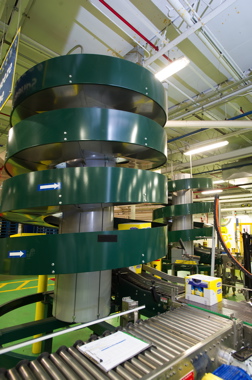
Manufactured by Ryson International, a towering spiral conveyor facilitates smooth and gentle transfer of loaded boxes of product upwards to the mezzanine level for palletizing.
“Consumers in the U.S. are very fond of the Clean Label Initiative, which is essentially about being able to read a label on their product and being able to pronounce all the ingredients in it,” he explains, “as well as understand that they are all-natural ingredients that are good and healthy for you.
“We’re just a little bit behind the U.S. in that respect at the moment,” he acknowledges, “but we’re about to undertake it in Canada, with plans to launch it in next year.”
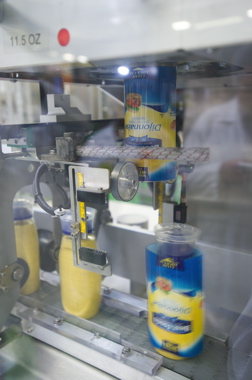
The squeeze-bottle line uses the same-sized base cap for each of the three bottle sizes.
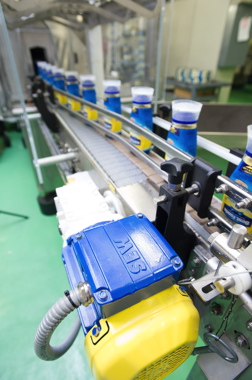
An SEW-Eurodvive motor powers a conveyor moving bottles from the heat-shrink tunnel.
In the meantime, Sienicki and his production floor troops are being kept busy fine-tuning and perfecting the new packaging line, commissioned by the Hellmann’s brand division, to fill and pack- age the brand’s many different formations and recipes into the easy-squeeze 11.5-, 20- and 25-ounce size bottles manufactured by Alpla, incorporating uniform-sized, clear protective bottom caps supplied by Berry Plastics.
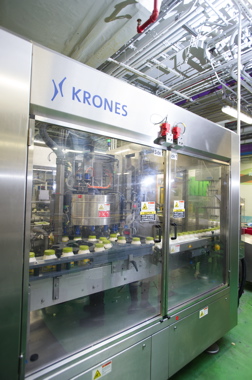
A Krones Canmatic rotary filler used to package round jars of Hellmann’s mayo.
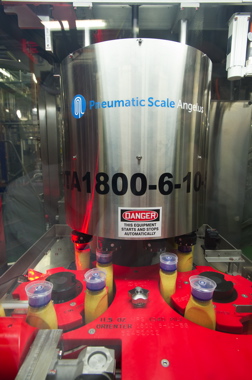
A Pneumatic Scale bottle orienter ensures each cap opening is always at the front.
Already retailing at some select retail chains, the colorful new bottles—adorned with high-impact graphics tightly wrapped around the bottle’s distinct contours with full-bodied shrinksleeves—are expected to be retailing nationally across Canada over the next year.
“We’re scheduled to produce about 38 million liters of Hellmann’s brand product this year,” Sienicki notes, “so there are many engineering and technical challenges involved to make it a successful conversion.”
Sienicki explains: “We have commissioned the new squeeze-bottle line with two primary goals in mind: to refresh the bottle with new graphics, but also to give consumers a so-called ‘clean bottle’ that enables them to dispense of virtually all of the product inside without any effort, or resorting to shaking or scooping the near-empty bottle to get at the product’s remains.”
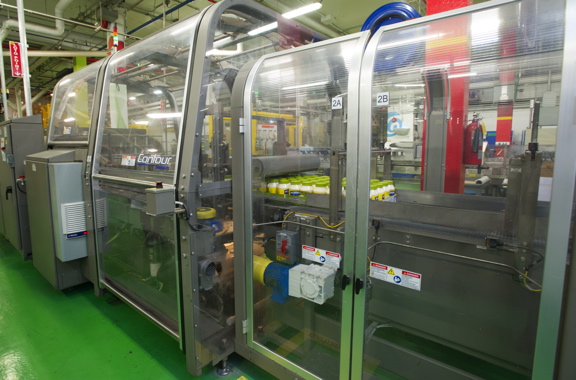
Manufactured by Douglas Machine, the Contour S-80 series shrinkwapper accommodates a broad range of sizes and pack patterns for high-speed case- and tray-packing applications.
The trick to pulling this off lies in the ingenious application of a fine misty layer of canola oil, already an active listed product ingredient in Hellmann’s product formulation, onto the inside of each bottle in the pre-filling stages on the packaging line.
“This creates very low-surface tension in the bottle to let more of the product out just by suing simple gravity,” says Sienicki.
This quick inline oil-spray application is expertly executed at dazzling throughput speeds by a converted rotary Serac oiler outfitted with high-precision Nordson dispensing nozzles originally designed and intended for hot-melt adhesive applicating.
“This is a totally custom-built machine designed for specifically for this very purpose,” Sienecki points out.
“There are only two of these machines in the world: one here at Rexdale and one at our sister Kilbourn Avenue facility in Chicago, with the only difference being the Kilbourn plant using soy oil, rather than canola to achieve the same effect.”
Says Sienicki: “In the past, one of the biggest consumer complaints about dressing products was the inability to get everything out to the last drop, but this new technology enables them to do exactly that.”
Atwal agrees: “Getting more product out of the package is a great consumer benefit, and the consumer feedback in the U.S. has been very positive.
“It’s a real value-added feature that we believe will provide a strong competitive edge for the brand out in the marketplace.”
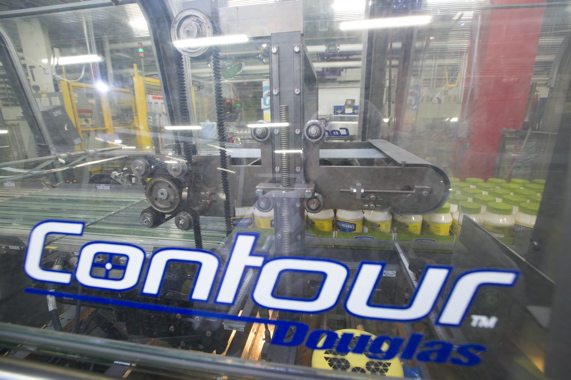
Filled trays of the Hellmann’s bran mayo jars inside the Contour S-80 series shrinkwrapper have a top layer of protective film applied by the system’s high-performance heat tunnel.
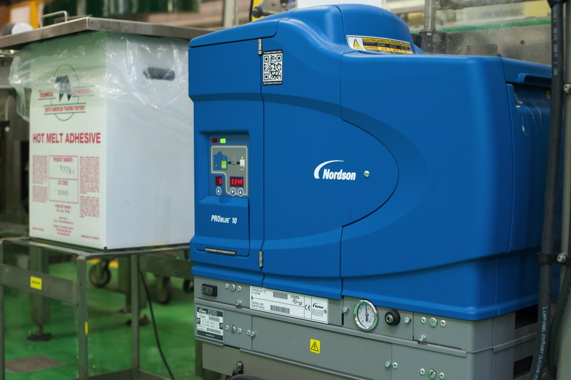
A high-volume Pro Blue 10 series hot-melt applicator from Nordson integrated into the Contour case-packer.
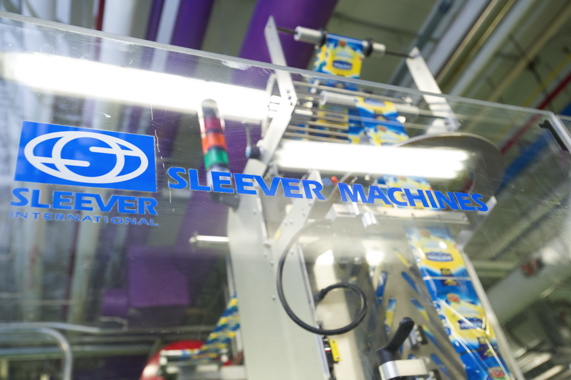
A new high-speed shrinksleeving machine from Sleever International used to decorate the new squeeze-bottles.
Despite the various engineering challenges involved along the way, Sienicki says he is largely satisfied with the pace and progress achieved in the conversion project so far.
“Every engineering change has its challenges but this has been largely a successful undertaking,” he confides.
“There were a couple of issues with positioning of spare parts, using different pallet patterns and different stops on conveyors, integrating new accumulation devices for feeding product into the case-packer and so on,” he says, “but now that we have completed a very robust training program with our maintenance staff and operators, we have a very good handle on the process.
“In hindsight, we have benefited from the luxury of learning about some of these challenges that the Kilbourn plant had gone through already in ramping up to the expected output levels, so we had validated all the changes with our machinery
suppliers before they built the next machine to go onto this line.
“We are at about a 50-percent commissioning level right now,” he states, “and we are hitting every milestone we expected to hit in advance of the launch.”
Sienicki cites impeccable attention to detail as one of the key factors to the project’s successful execution to date.
“Different bottles handle in different ways on the line, so with the smallest bottle being a little bit top-heavy and more prone to tipping in the case packer, we had to make some modifications there to ensure our cases are filled smoothly and consistently without jamming,” he says.
“Likewise, using a standard same-sized cap for different bottle sizes has an impact on shrinksleeving, especially for the smaller-sized containers, and the capper also had to be modified to accommodate the new cap design.”
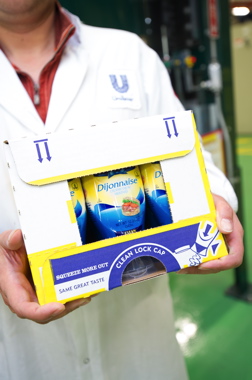
A fully-loaded, shelf-ready corrugated box from Atlantic Packaging designed for easy handling at the retail level.
To facilitate these and other changes, the line commissioned a brand new bottle orienter to optimize the process.
“Whereas we used to just dump the bottles into the hoppers and then orient them with another machine, the new orienter not only does that in one step, but it also uses a special stop-cap mechanism to ensure that each and every cap-opening will be positioned right at the front of the label, rather than taking a 50-per cent chance that it may end up either at the front or the back.
“It may sound like a small thing, but there is no substitute for leaving nothing to chance—be it food safety or packaging execution.”
This uncompromising food safety approach is vividly demonstrated on the plant’s production floor with broad array of CIP (clean-in-place)-designed processing and packaging equipment, strategically positioned to optimize the plant’s tight available floorspace divided into nine packaging lines—six for spreads and three for dressings.
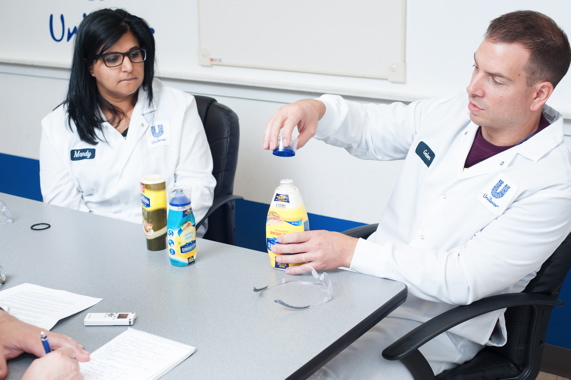
Sienicki displays some of the unique packaging components incorporated into the new plastic squeeze bottles, manufactured by Alpla, used to package the Hellmann’s brand dressings.
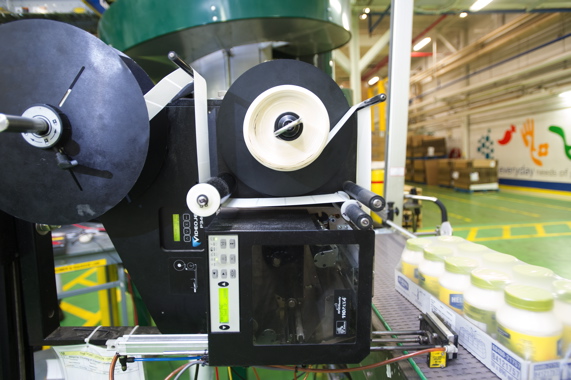
A Videojet model P3400 label printer-applicator applies product labels onto the sides of loaded corrugated trays.
In addition, the plant made a significant investment to install state-of-the-art X-Ray product inspection technology on some of its key lines to prevent possible product contamination.
Distributed in Canada by PLAN Automation of Orangeville, Ont., the Rexdale plant’s three Eagle Pro X-Ray inspection machines—manufactured by the Tampa Bay, Fla.-based Eagle Product Inspection—play a key strategic role in the plant’s proactive product safety regimen by thoroughly checking the final product for the tiniest traces of foreign particles or debris, as well as other imperfections, before the tubs of margarine or bottles or dressing make their way to the case-packer.
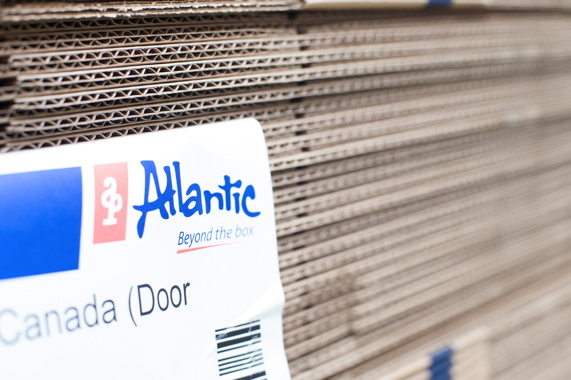
Toronto-based Atlantic Packaging Products supplies the lion’s share of the Rexdale plant’s corrugated packaging.
“These machine do an excellent job of looking for an pinpointing any foreign matter, with instant and easy-to-use metal detection capabilities, and they can be taught and programmed to identify other unwanted substances by measuring product density,” Sienicki says, “and they also have the ability to verify the weight of the product.”
Purchased over the course of the year, the Eagle Pro X-Ray systems represent a “far large investment than we would have had to make with installing traditional metal detectors,” Sienicki points out, but they also offer a lot more capability.
“You can teach them to do things like being able to recognize the tamper-evident metal inner lidding that we use on some of the products, whereas a metal detector would reject every container.”
Each of the X-Ray systems is positioned nearby the respective line’s inkjet date coders, including the Markem-Imaje S8 Classic series small-character coders, which perform high-speed application of best-before dates and the time of manufacture to ensure full product traceability.
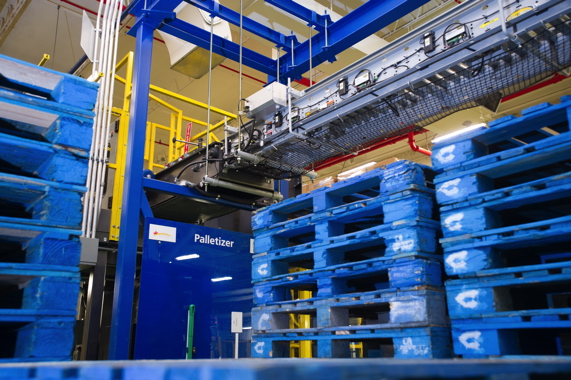
The Columbia Machine palletizer uses signature-blue CHEP pallets to palletize the finished product loads.
“Our spread product shelf-life typically ranges from six to nine months,” Sienicki says, noting the spread lines normally run from 120 and 160 tubs per minute, depending on product size and other variables.
“Our throughput to capacity is limited to about 14,000 pounds of product that or MPUs (margarine processing units) can turn out, as well as our casepacker’s throughput rate, because it can only make so many movement per minute.
“We typically fill our shipping cases with about 24 pounds of product, and it takes a lot more movement to put 48 half-pound tubs of product in the cases than 12 two-pound tubs, so our line speeds will fluctuate to accommodate the differences,” he says.
Atwal adds that as part of the plant’s recently-launched in-house CRQS (consumer-relevant quality standards) program, “Machine operators take six tubs off the line every hour and to evaluate them against different criteria, like print quality, to make sure consumers will be delighted with each package they purchase.
“We also have a team that actually goes inside the stores and evaluates the packages out on the shelves, after which we compare their findings with our factory results,” she relates.
Not surprisingly, the same stringent quality control and attention to detail are applied to the recently started squeeze-bottle line, which processes between 160 and 195 containers per minute, depending on bottle size.
The packaging process commences at the Pneumatic Scale bottle orienter and a towering Sidel cap sorter to match the main components in proper sequence, and moves onto a modified Pacific Packaging rotary filler/capper after the bottles have passed through the aforementioned modified Serac oiler for a quick spray application of canola oil mist.
After the containers are precision-filled, capped and inspected by another Eagle Pro X-Ray inspection system, they pass through a high-performance heat-shrink tunnel—manufactured by Sleever International—followed by application of a tamper-evident seal underneath the cap by a Super Seal induction heat-sealer manufactured by Enercon Corporation.
“We purchase our caps with the seals already in them, so when they pass through induction sealer those seals are literally welded to the top rim of the container,” Sienicki explains.
The finished bottles are then swiftly conveyed in four lanes to a state-of-the-art, fully-automatic case-packer—manufactured by Douglas Machine Corporation—equipped with a large-sized Nordson Pro Blue 10 hot-melt adhesive applicator. Once the case-packer packs the bottles inside the corrugated shipping containers—supplied to the plant by Toronto-based boxmaker Atlantic Packaging Products Limited—the product is moved down the line by a Ryson spiral conveyor towards one of two fully-automatic palletizers manufactured by Columbia Machine, Inc. The high-volume palletizing machines—used interchangeably by the spread and dressing products as required—quickly arrange the filled cases into pre-programmed layer patterns on top of the signature-blue CHEP wooden pallets, which are moved by heavy-duty metal conveyor rollers towards a fully-automatic Orion rotary-arm stetchwrapper to secure and stabilize the loads before they are wheeled out by forklift for transport and distribution.
Says Sienicki: “Because we are still commissioning the squeeze-bottle line, we’re trying to limit ourselves to running one size of bottles per week to keep the changeovers to a minimum while we’re working out any bugs.
“But after we have established a good comfort level, we intend to change products on the line at least once a day, and the packaging sizes once a week, to become a more flexible operation.”
While the Rexdale plant is still not as optimally automated as it ultimately can be, according to Sienicki, “For the amount of product we make here, we are able to do it with a fairly ‘lean’ staff.”
Says Sienicki: “These are exciting time for the Rexdale plant and the entire team here, and we are looking forward to an exciting future with new products, new technologies, and new capabilities in both food safety and continuous product innovation and diversity.”
Advertisement

